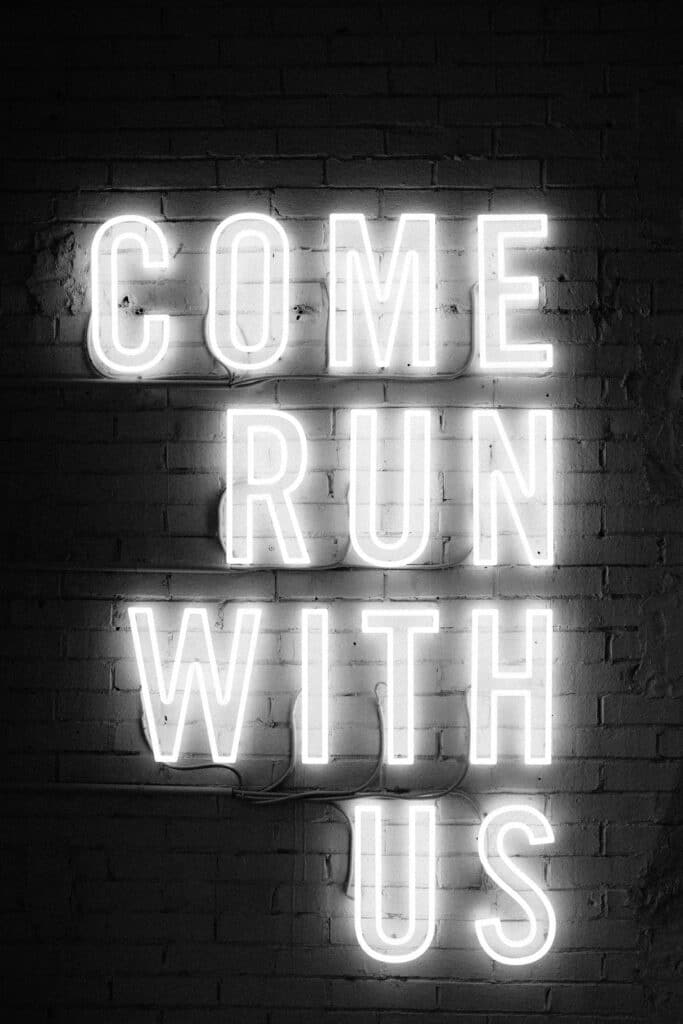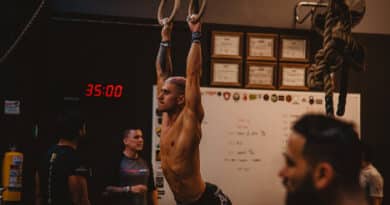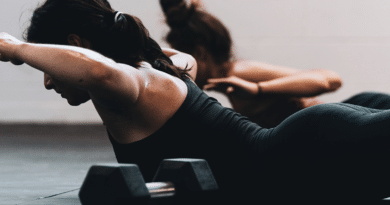25 Running Workouts for Health, Fitness and Endurance
Running Workouts are a great way to improve your endurance, general health, heart and cardiovascular system.
This article will provide you with 25 functional fitness Running Workouts and help you fully understand the Cardiovascular System, Aerobic Capacity, VO2 Max and the different energy systems you need for different forms of running.
- What is the Cardiovascular System?
- Aerobic Capacity / VO2 Max
- The Difference Between Aerobic and Anaerobic Exercise
- FORMS OF ENDURANCE
- RUNNING TECHNIQUE
- RUNNING WORKOUTS
- Workout 1
- Running Workouts 2
- Running Workouts 3
- Running Workouts 4
- Workout 5
- Running Workouts 6
- Workout 7
- Workout 8
- Running Workouts 9 – Helen
- Running Workouts 10
- Running Workouts 11
- Workout 12
- Running Workouts 13 – Kelly
- Running Workouts 14
- Workout 15
- Running Workouts 16
- Workout 17
- Workout 18
- Running Workouts 19
- Workout 20
- Workout 21
- Running Workouts 22
- Workout 23
- Running Workouts 24 – Eva
- Workout 25 – Triple 3
- Running Workouts FAQs
- Can I Get in Shape Just by Running?
- Is a 20 Minute Run a Good Workout?
- What is Runner’s Face?
- What is Runner’s Stomach?
- Why are Runner’s so Skinny?
- Can I Lose Weight by Just Running?
- Can Running Reduce Belly Fat?
- How Quickly Will I See Results from Running?
- Is it OK to Run 5 Miles Every day?
- Do your Legs get Bigger from Running?
- Can Running Give You Abs?
- Can Running Reduce Breast Size?
- Running Workouts
What is the Cardiovascular System?
A more developed Cardiovascular System will enable any athlete to go harder for longer, remove lactic acid from muscles more efficiently and deliver a better and constant supply of oxygen to their bodies.
An improved Cardiovascular System also lowers the risk of heart disease and improves heart and lung function.
The term “cardiovascular” relates to the heart and blood vessels and includes arteries, veins, and capillaries.
The heart is a pump that sends blood throughout our bodies, carrying oxygen to every cell.
After delivering the oxygen, the blood returns to the heart.
The heart then sends the blood to the lungs to pick up more oxygen. This cycle repeats over and over again.
The circulatory system is made up of blood vessels that carry blood away from and towards the heart.
- Arteries carry oxygenated blood away from the heart
- Veins carry blood back to the heart
The circulatory system carries oxygen, nutrients, and hormones to cells, and removes waste products, like carbon dioxide.
These roadways travel in one direction only.
Aerobic Capacity / VO2 Max
Aerobic capacity is the maximum amount of oxygen that can be used while engaging in an activity.
During exercise, the demands on your cardiovascular system increase as your muscles require more oxygen in order to maintain their output.
Your cardiovascular system responds by increasing your heart rate, blood pressure and redirecting blood flow in order to maximize the amount of oxygen delivered to your muscles.

The capacity of the cardiovascular system to regulate blood flow and supply oxygen to working tissues is critical to exercise performance.
The Difference Between Aerobic and Anaerobic Exercise
Literally, Aerobic means “with oxygen” and Anaerobic means “without oxygen”.
Aerobic exercise includes activities such as longer distance running, swimming and cycling, sustained at lower intensities over lengthier periods of time.
Anaerobic exercise includes sprinting and other high intensity forms of exercise.
Think bursts of unsustainable energy such as sprint workouts or a 400m running race.
FORMS OF ENDURANCE
The Cardiovascular System works across a broad range of domains and thresholds, and it is always an advisable idea to train your body across this entire spectrum.
Find your perfect running shoes.
See below how different forms of training will have varying effects on the human body and how to train based on what you want to improve.
- Aerobic Threshold: Steady workouts at a moderate intensity to develop fuel efficiency (burn fat), muscular skeleton system, and aerobic endurance.
- Lactate Threshold: Higher volume workouts with longer distance intervals at higher “threshold” intensities with less rest between reps and/or sets.
- VO2 Max: Lower volume workouts, shorter distance intervals at higher intensities, and more rest between reps and/or sets.
- Speed Endurance: Very low volume workouts with interval distances less than 60sec. Extremely high intensities. Used to recruit fast twitch fibres and force them to develop endurance. Full recovery between reps and/or sets.
- Strength Endurance: Low volume workouts with high intensity intervals that include various explosive movements to recruit and develop your fast twitch muscle fibres.
RUNNING TECHNIQUE
RUNNING WORKOUTS
These Running Workouts will help you to improve your health, fitness and conditioning in many different ways.
Why humans evolved to be great long distance runners
Add them into your training.

Workout 1
4 Rounds for Time
- 800 metre Run
- 49 Push-Ups
- 49 Sit-Ups
- 49 Air Squats
With a running clock, as fast as possible perform four rounds of the prescribed work in the order written.
Score is the time on the clock when the last round of Air Squats is completed.
Running Workouts 2
6 Rounds for Time
- 24 Air Squats
- 24 Push-Ups
- 24 Walking Lunges
- 400 metre Run
With a running clock, as fast as possible perform the prescribed work in the order written for 6 rounds.
Score is the time on the clock when the final 400 metre Run is completed.
Tips and Strategy
There are enough movements (and low enough volume per set) to avoid any major muscle fatigue.
Pick a strong pace from the beginning, and go faster as the rounds progress. Round 6 should be a sprint.
Intended Stimulus
This is a workout designed to challenge your bodyweight strength and your cardiovascular endurance.
The athlete should be moving fast and breathing heavily for the majority of the WOD.
This workout should feel a little too long, like it should have only been 4 rounds—not 6.
Scaling Options
Scale the volume (either the total number of rounds or reps) as needed to move smoothly and quickly. A strong pace—and minimal rest breaks—is important to get the benefits of this workout.
Beginner
4 Rounds for Time
- 24 Air Squats
- 24 Push-Ups
- 24 Walking Lunges
- 400 metre Run
Quotes from barefoot marathon runner and Harvard Professor Daniel Lieberman
Running Workouts 3
For Time
- 1 mile Run
- 2,000 metre Row
- 1 mile Run
Running Workouts 4
3 Round for Time
- 30 Squat Cleans (95/65 lb)
- 30 Pull-Ups
- 800 metre Run
With a running clock, as fast as possible complete the prescribed work in the order written for 3 rounds.
Score is the time on the clock when the last round of the 800 metre Run is completed.
Workout 5
6 Rounds for Time
- 400 metre Run
- 10 Toes-to-Bars
- 10 Atlas Lunges (65/55 lb)*
1 Atlas Lunge is Back Rack Left Reverse Lunge + Back Rack Right Reverse Lunge + Back Squat
With a running clock, complete 6 rounds of the prescribed work in the order written as fast as possible (“For Time“).
Score is the time on the clock when the last round of the Atlas Lunges is completed.

Scaling Options
AMRAP in 16 minutes
- 1 minute Jog/Run/Row/Bike
- 12 Sit-Ups
- 8 Unweighted Lunges
Check out these Reebok x National Geographic running shoes
Running Workouts 6
For Time
- 20 Deadlifts (275/185 lb)
- 400 metre Run
- 20 Kettlebell Swings (2/1.5 pood)
- 400 metre Run
- 20 Overhead Squats (115/75 lb)
- 400 metre Run
- 20 Burpees
- 400 metre Run
- 20 Chest-to-Bar Pull-Ups
- 400 metre Run
- 20 Box Jumps (24/20 in)
- 400 metre Run
- 20 Dumbbell Squat Cleans (45/35 lb)
- 400 metre Run
With a running clock, as fast as possible perform the prescribed work in the order written.
Score is the time on the clock when the last 400 metre run is completed.
Workout 7
For Time
- 2 Mile Run
- 2 Minutes Rest
- 20 Squat Cleans (135/95 lb)
- 20 Box Jumps (24/20 in)
- 20 Overhead Walking Lunges (45/25 lb plate)
- 20 Box Jumps (24/20 in)
- 20 Squat Cleans (135/95 lb)
- 2 minutes Rest
- 2-mile Run
Wear a weight vest (20/14 lb)
Workout 8
For Time
- 800 metre Run
- 21 Thrusters (45/25 kg)
- 21 Push-Ups
- 21 Box Jumps (24/20 in)
- 600 metre Run
- 15 Thrusters (45/25 kg)
- 15 Push-Ups
- 15 Box Jumps (24/20 in)
- 400 metre Run
- 9 Thrusters (45/25 kg)
- 9 Push-Ups
- 9 Box Jumps (24/20 in)
- 200 metre Run
With a running clock, complete the prescribed work in the order written as fast as possible (“For Time”).
Score is the the time on the clock when the last 200 metre Run is completed.
Running Workouts 9 – Helen
3 Rounds for Time
- 400 metre Run
- 21 Kettlebell Swings (1.5/1 pood)
- 12 Pull-Ups
With a running clock, as fast as possible perform the 3 rounds of work in the order written.
Score is the time it takes to complete 3 rounds.
Good Times for “Helen”
– Beginner: 15-17 minutes
– Intermediate: 11-14 minutes
– Advanced: 9-10 minutes
– Elite: <8 minutes
Tips and Strategy
“The first goal in Helen is to push for unbroken sets on the work inside the gym.
In order to do so, we are looking at pacing the runs to ensure we can accomplish these numbers in big, consistent chunks across all three rounds.
Just like on “Nancy”, we would rather slow down the runs a touch if that allows you to hold onto the bell and pull-up bar.
If we have the movements on the inside of the gym unbroken without a doubt, it’s the opposite approach – it’s a question of how hard can we push the running.
For athletes with previous scores, doing the math for what split they need to hold across the three rounds will help them feel out if they are on track when they leave the building after round one.” – Ben Bergeron
Intended Stimulus
Helen is meant to feel fast and light.
The volume on this workout is relatively low, so the movements should be unbroken.
If you have to rest for long periods of time or break the Pull-Up/Kettlebell Swings into more than 2 sets, you’ll lose the intended intensity.
Scale as needed to achieve a fast pace throughout the WOD.
Scaling
This benchmark workout is an all-out sprint. The swings and pull-ups should be easy enough that you are still able to push the pace on the runs. Intermediate athletes can complete this as prescribed.
Beginner Option
3 Rounds for Time:
- 200 metre Run
- 15 Kettlebell Swings (1/.75 pood)
- 9 Jumping Pull-Ups
Running Workouts 10
For Time
- 50 Pull-Ups
- 400 metre Run
- 21 Thrusters (95/65 lb)
- 800 metre Run
- 21 Thrusters (95/65 lb)
- 400 metre Run
- 50 Pull-Ups
Running Workouts 11
5 Rounds for Time
- 22 Kettlebell Swings (2/1.5 pood)
- 22 Box Jumps (24/20 in)
- 400 metre Run
- 22 Burpees
- 22 Wall Ball Shots (10/9 ft, 20/14 lb)
Browse Reebok x Adventure Running Shoes
Workout 12
For Time
- 800 metre Run (with 25/15 lb Plate)
Then:
14 Rounds of:
- 5 Strict Pull-Ups
- 4 Burpee Box Jumps (24/20 in)
- 3 Cleans (185/135 lb)
Then:
- 800 metre Run (with 25/15 lb Plate)
Running Workouts 13 – Kelly
5 Rounds for Time
- 400 metre Run
- 30 Box Jumps (24/20 in)
- 30 Wall Ball Shots (20/14 lb)
With a running clock, as fast as possible perform the prescribed work in the order written for 5 rounds.
Score is the time on the clock when the last round of Wall Ball Shots is completed.
Good Times for “Kelly”
– Beginner: 34-40 minutes
– Intermediate: 25-31 minutes
– Advanced: 19-22 minutes
– Elite: <18 minutes
Tips and Strategy
Start out with a moderate pace on this high-volume benchmark workout—a fast pace out of the gate will prove to be a mistake.
Quality breathing during all of the movements (especially the Wall Ball Shots) is necessary to keep the heart rate from spiking too high.
Match the breath with the movement (i.e. inhale to catch the Medicine Ball, exhale to throw it to the target) to help keep the breath steady and consistent.
Intended Stimulus
This should be a long grind with a healthy number of reps.
Juan Acevedo states “We want you to be able to keep going, but we want a big resistance from your body saying: ‘can we stop now, please?’
In that delicate and constant battle is where we want you today. Moreover, when you are there we want you to smile and move on.
That’s the stimulus that’ll guide our scaling. If modifying, keep a high number of reps and rounds, but decrease skill and overall workload to match today’s capacity.”
Scaling Options
Scale the skill level of the Box Jumps and/or the volume of the repetitions/rounds to move smoothly and effectively through the WOD.
If the athlete takes longer than 7 minutes to complete the first round, they should scale back.
This workout shouldn’t take much longer than 35-40 minutes.
Intermediate
5 rounds for time of:
- 400 metre Run
- 30 Box Jumps (20/16 in)
- 30 Wall Ball Shots (14/12 lb, 10 ft)
Beginner
4 rounds for time of:
- 200 metre Run
- 20 Box Step-Ups (20/16 in)
- 20 Wall Ball Shots (14/12 lb, 9 ft)
Running Workouts 14
For Time
- 1.5-mile Run
- 150 Burpees
- 1.5-mile Run
Wear a Weight Vest (20/14 lb)
Workout 15
5 Rounds for Time
- 400 metre Run
- 30 GHD Sit-Ups
- 15 Deadlifts (250/165 lb)
Scaling
Intermediate
Five rounds for time of:
- Run 400 metres
- 24 GHD sit-ups
- 12 deadlifts (250/165 lb)
Beginner (A)
Five rounds for time of:
- Run 400 metres
- 30 AbMat sit-ups
- 12 deadlifts (165/115 lb)
Beginner (B)
Five rounds for time of:
- Run 250 metres
- 20 AbMat sit-ups
- 10 deadlifts (115/80 lb)
Running Workouts 16
4 Rounds for Time
- 40 Air Squats
- 30 Hand-Release Push-Ups
- 20 Burpees
- 400 metre Run
On a running clock, perform 4 rounds of the prescribed work in the order written as fast as possible (“For Time”).
Score is the time on the clock when the last Run is finished.
Workout 17
For Time
- 10-mile Run
Every mile, perform:
- 10 Burpees
With a running clock, as fast as possible complete 10 miles. Every 1 mile completed, perform 10 Burpees before continuing the Run.
Score is the time on the clock when the 10-mile Run is completed.
Workout 18
For Time
- 10-mile Run
- 150 Burpee Pull-Ups
With a running clock, as fast as possible (“For Time“) complete 10 mile Run and 150 Burpee Pull-Ups. Partition the Run and Burpee Pull-Ups as needed.
Score is the time on the clock when the workout is completed.
Running Workouts 19
AMRAP in 20 minutes
- 400 metre Run
- Max Pull-Ups
On a 20-minute clock, perform a 400-metre run, then complete as many Pull-Ups as possible in a single set (unbroken, meaning a drop from the pull-up bar, touching the ground, or otherwise resting in any position other than a hang counts as a break and the end of the set).
Continue immediately to another Run and another max set of Pull-Ups.
Repeat until the 20-minutes is up.
Score is the total number of Pull-Ups completed (cumulative across all rounds) before the 20-minute clock stops.
Workout 20
AMRAP in 19 minutes
- 1 mile Run
Then, 5 Rounds of:
- 27 Air Squats
- 18 Push-Ups
If you finish, start again on the run.
Workout 21
For Time
- 6-minute Hang Hold (cumulative)
Each time you drop from the bar, perform:
- 800 metre Run
- 30 Push-Ups
With a running clock, athlete starts the workout by free-hanging by the hands only from a pull-up bar.
If athlete drops from the pull-up bar before 6 minutes, take note of the time but do not stop the clock. Once the run and push-ups are complete, resume the hang hold.
Repeat until cumulative hang hold time reaches 6 minutes. Score is the total time, including the time it takes to do all runs and push-ups.
Running Workouts 22
For Time
- 800 metre Run
- 30 Squat Snatches (95/65 lb)
- 400 metre Run
- 30 Hang Cleans (95/65 lb)
- 200 metre Run
- 30 Back Squats (95/65 lb)
- 400 metre Run
- 30 Push-Ups
- 800 metre Run
- 30 Pull-Ups
With a running clock, complete the prescribed work in the order written as fast as possible (“For Time”).
Score is the time on the clock when the last Pull-Up is completed.
Workout 23
For Time
- 800 metre Run
- 50 Back Squats (135/95 lb)
- 50 Bench Press (135/95 lb)
- 800 metre Run
- 35 Back Squat (135/95 lb)
- 35 Bench Press (135/95 lb)
- 800 metre Run
- 20 Back Squat (135/95 lb)
- 20 Bench Press (135/95 lb)
- 800 metre Run
Running Workouts 24 – Eva
5 Rounds for Time
- 800 metre Run
- 30 Kettlebell Swings (2/1.5 pood)
- 30 Pull-Ups
With a running clock, perform 5 rounds of the prescribed work in the order written as fast as possible (“For Time”).
Score is the time on the clock when the last round of pull-ups is completed.
Good Times for “Eva”
– Beginner: 59-66 minutes
– Intermediate: 44-54 minutes
– Advanced: 35-39 minutes
– Elite: <32 minutes
Scaling Options
This classic benchmark is a long workout with significant volume. Reduce the volume or go lighter, but expect to need multiple sets to complete each set of 30 reps.
Intermediate
4 Rounds for Time
- 800 metre Run
- 30 Kettlebell Swings (24/16 kg)
- 30 Pull-Ups
Beginner
5 Rounds for Time
- 400 metre Jog
- 20 Kettlebell Swings (16/12 kg)
- 20 Pull-Ups
Workout 25 – Triple 3
For Time
- 3,000 metre Row
- 300 Double-Unders
- 3-mile Run
Scaling Options
Massively reduce the volume.
This should be a long-duration workout, but not so long that you die. Try single-unders. Keep it long.
Beginner
For time:
- 1,000 metre Row
- 100 Single-Unders
- 1-mile Run
Running Workouts FAQs
Still got questions? We’ve got you covered.
Can I Get in Shape Just by Running?
Yes. You will not bulk up and build muscle but your body will change.
According to Sydney based trainer Jono Castano, “Running is a great form of cardio, but it certainly is quite different to weights and resistance training, so the answer is yes, it will affect your strength and the shape of your body”.
Is a 20 Minute Run a Good Workout?
Yes. Especially for beginners this is an excellent time duration to build consistency and make running a habit in your life. This is turn will lead to improved health, fitness and body composition in the long run.
If you know you’ve only got to run for 15-20 minutes, you’ll be less tempted to skip a run. If you run for 20 minutes each day, you’ll burn approximately 200 calories.
What is Runner’s Face?
“Runner’s face,” as it’s been called, is a term some people use to describe the way a face can look after many years of running.
And while the appearance of your skin can change due to a variety of factors, running doesn’t specifically cause your face to look this way.
What is Runner’s Stomach?
Runner’s stomach occurs when our digestive system experiences a large amount of agitation from the act of running or high-endurance exercise.
There are certain diet tips you can follow to avoid having an accident mid-run.
Why are Runner’s so Skinny?
Professional marathon runners are considered skinny because they train so hard to build incredible endurance. Their bodies are specifically adapted to be optimised for long distance running.
They do not want extra weight in the form of fat or muscle because that means more weight to carry whilst running.
Can I Lose Weight by Just Running?
Yes. However, this must be combined with intelligent decisions in regards to nutrition.
If you eat more calories that you expend every day (Calorie surplus) your body will store the extra as fat. If you burn more calories that you consume every day (Calorie deficit) you will lose weight.
If you add running into your lifestyle without changing anything else (and you eat the same) you will burn more calories than before. You can lose weight just by running if your routine boosts your activity level beyond what it was before.
Can Running Reduce Belly Fat?
Yes, running can make you lose belly fat? Running is an incredibly effective fat burning exercise. In fact, when it comes to losing weight, it’s difficult to beat.
How Quickly Will I See Results from Running?
You will see results from running in 4-6 weeks. If you follow a set running schedule or programme you may notice results in your performance in 4-6 weeks. It may take longer if you have a more sporadic running plan. Beginners will often notice physical improvements more quickly as the body soon adapts to a new training stimulus.
Is it OK to Run 5 Miles Every day?
If you’re new to running it’s best to build your mileage gradually and take one or two rest days of light exercise such as walking. For a seasoned runner it’s OK to run 5 miles a day, but if you’re injury prone, new to running, a heavier or older runner, running every day may be excessive.
Do your Legs get Bigger from Running?
Running uses your glutes, quadriceps, hamstring and calves constantly, meaning that your leg muscles are working and this will cause them to develop. Running will not enhance muscle mass in the same was as specific hypertrophy training with weights.
Can Running Give You Abs?
While most runners don’t run solely to get abs or tone their body, it can be a nice side benefit of the sport. While running is primarily a cardio exercise, it does strengthen and tone many muscles in your body, including your abs.
Can Running Reduce Breast Size?
Regular exercise can help shed chest fat and strengthen the muscles underneath the breasts to reduce their size.
Because the breasts contain a portion of fat, focusing on cardio and high-intensity exercises can help shed weight faster and target problem areas.
Running Workouts
If you enjoyed these workouts then try these Running Quotes from Haruki Murakami or Wall Sit Workouts and Leg Exercises to build stronger, fitter legs.





Comments are closed.